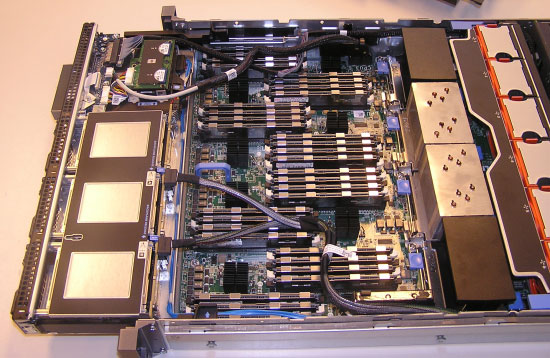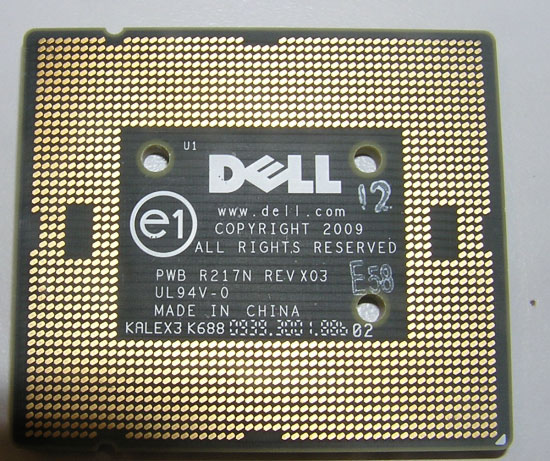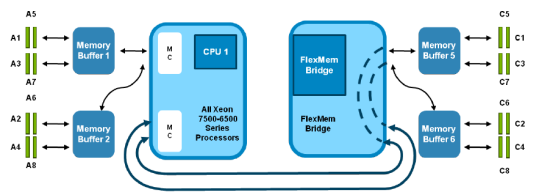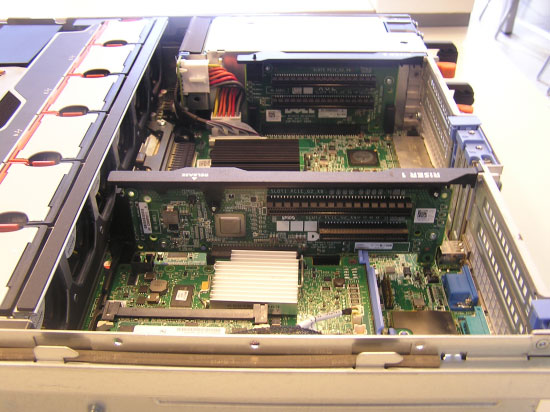High-End x86: The Nehalem EX Xeon 7500 and Dell R810
by Johan De Gelas on April 12, 2010 6:00 PM EST- Posted in
- IT Computing
- Intel
- Nehalem EX
Dell R810 and Intel Nehalem EX Platform
Dell no longer seems to focus on cost alone, but also on offering innovative features. In the new Dell servers we find two very interesting features that set them apart from the pack. The first one is a new redundant SD-card module for embedded hypervisors. This module is similar to previous embedded hypervisor SD card solutions, but adds mirroring to the feature set. You cannot install any form of Windows on it as Windows refuses to be installed on a "removable USB device". 1GB might be enough for some Linux installations, but the enterprise versions require more than 1GB most of the time. So it only seems fit for an ESXi hypervisor.
The server has no less than 32 DIMMs, which are available even if you install only two CPUs. This second innovation is called the "FlexMem Bridge" technology. You can see in the picture below that only two aluminum heatsinks with copper heatpipes are installed. The other two are rather simple black heatsinks.

When we remove those black heatsinks, we find the pass-through chip.

And below is the pass-through chip seen from the underside.

Having as many DIMMs on a quad-socket as on a dual-socket is pretty cool, though there are some limitations you should be aware of. The FlexMem Bridge is in fact a pass-through for the second memory controller, as you see can below.

This should add a little bit of latency, but more importantly it means that in a four-CPU configuration, the R810 uses only one memory controller per CPU. The same is true for the M910, the blade server version. The result is that the quad-CPU configuration has only half the bandwidth of a server like the Dell R910 which gives each CPU two memory controllers.
The Dell R810 is simply not meant to be the highest performing Xeon 7500 server out there. The reality is that a significant number of buyers out there will shrug their shoulders when reading that 32 Nehalem cores are not running at full speed. Those buyers view the two extra CPUs as an unnecessary cost to obtain their real goal: getting a server with a copious amount of memory. If you are consolidating lightly loaded but critical web servers, firewalls, software routers, LDAP, DNS and other infrastructure applications, chances are you will never even need 16 cores to power them.
With the R810 Dell created the "entry-level" server for the Xeon 7500 market. It offers the reliability features of Intel's newest Xeon, 32 DIMMs slots, and excellent expansion options with six PCIe slots.

So the natural processor configuration for the Dell R810 is the dual Xeon 6500 series. When we specced a system with a dual E6540 2GHz, 128GB (32x4GB) and redundant PSU costs, we ended up with a price tag of $14400. For reference, a similar R710 with two Xeon E5540 and 128GB arrived at $11400. The latter system has to use sixteen 8GB DIMMs which raises the price quite a bit. But still $3000 difference is acceptable as the R810 delivers more expansion possibilities and is in a different class when it comes to reliability. For RISC buyers, a fully equipped system with these reliability features in the range of $14-$20k must sound cheap.
Quad Opteron 6100 systems will offer up to 48 DIMM slots. At the time of writing, we could not find server systems based on quad Opterons. It is clear that these systems will be cheaper, but an in-depth analysis of how reliability features influence these "massive memory" systems is necessary to make any reality-based conclusion. For now, we can state that the Dell R810 is making the Xeon 7500 market more accessible.










23 Comments
View All Comments
dastruch - Monday, April 12, 2010 - link
Thanks AnandTech! I've been waiting for an year for this very moment and if only those 25nm Lyndonville SSDs were here too.. :)thunng8 - Monday, April 12, 2010 - link
For reference, IBM just released their octal chip Power7 3.8Ghz result for the SAP 2 tier benchmark. The result is 202180 saps for approx 2.32x faster than the Octal chipNehalem-EXJammrock - Monday, April 12, 2010 - link
The article cover on the front page mentions 1 TB maximum on the R810 and then 512 GB on page one. The R910 is the 1TB version, the R810 is "only" 512GB. You can also do a single processor in the R810. Though why you would drop the cash on an R810 and a single proc I don't know.vol7ron - Tuesday, April 13, 2010 - link
I wish I could afford something like this!I'm also curious how good it would be at gaming :) I know in many cases these server setups under-perform high end gaming machines, but I'd settle :) Still, something like this would be nice for my side business.
whatever1951 - Tuesday, April 13, 2010 - link
None of the Nehalem-EX numbers are accurate, because Nehalem-EX kernel optimization isn't in Windows 2008 Enterprise. There are only 3 commercial OSes right now that have Nehalem-EX optimization: Windows Server R2 with SQL Server 2008 R2, RHEL 5.5, SLES 11, and soon to be released CentOS 5.5 based on RHEL 5.5. Windows 2008 R1 has trouble scaling to 64 threads, and SQL Server 2008 R1 absolutely hates Nehalem-EX. You are cutting Nehalem-EX benchmarks short by 20% or so by using Windows 2008 R1.The problem isn't as severe for Magny cours, because the OS sees 4 or 8 sockets of 6 cores each via the enumerator, thus treats it with the same optimization as an 8 socket 8400 series CPU.
So, please rerun all the benchmarks.
JohanAnandtech - Tuesday, April 13, 2010 - link
It is a small mistake in our table. We have been using R2 for months now. We do use Windows 2008 R2 Enterprise.whatever1951 - Tuesday, April 13, 2010 - link
Ok. Change the table to reflect Windows Server 2008 R2 and SQL Server 2008 R2 information please.Any explanation for such poor memory bandwidth? Damn, those SMBs must really slow things down or there must be a software error.
whatever1951 - Tuesday, April 13, 2010 - link
It is hard to imagine 4 channels of DDR3-1066 to be 1/3 slower than even the westmere-eps. Can you remove half of the memory dimms to make sure that it isn't Dell's flex memory technology that's slowing things down intentionally to push sales toward R910?whatever1951 - Tuesday, April 13, 2010 - link
As far as I know, when you only populate two sockets on the R810, the Dell R810 flex memory technology routes the 16 dimms that used to be connected to the 2 empty sockets over to the 2 center CPUs, there could be significant memory bandwidth penalties induced by that.whatever1951 - Tuesday, April 13, 2010 - link
"This should add a little bit of latency, but more importantly it means that in a four-CPU configuration, the R810 uses only one memory controller per CPU. The same is true for the M910, the blade server version. The result is that the quad-CPU configuration has only half the bandwidth of a server like the Dell R910 which gives each CPU two memory controllers."Sorry, should have read a little slower. Damn, Dell cut half the memory channels from the R810!!!! That's a retarded design, no wonder the memory bandwidth is so low!!!!!